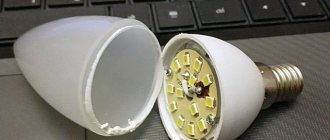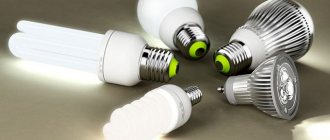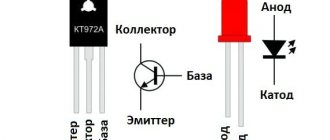Few people think about it, but an ordinary incandescent lamp has given every modern person another 6 years of active life.
Before its invention, people slept on average 10 hours a day, after - only 7.5 hours.
Many of you have probably heard the story of the Livermore (California, USA) fire department light bulb, which has been burning there continuously since 1901.
There is even an online broadcast of this process on the Internet - TYTS. To date, the light bulb has worked continuously for more than 1 million hours!
A natural question arises: why don’t light bulbs shine for so long in our homes?
For some, they wear out within weeks or even days of replacement. And there are two explanations: technology and conspiracy.
Moreover, they both have the right to exist. We will look at both in turn, and you, having already made the appropriate conclusions, can take the necessary actions and try to solve the problem.
How do incandescent lamps burn out?
According to GOST standards, the established voltage limits are the norm, and only for light bulbs are they critical. Let's explain. The temperature of the filament is 2-2.2 thousand °C. When a current greater than the rated current is supplied to the tungsten filament, its temperature increases by 10 percent.
The higher the temperature, the more intense the tungsten atoms evaporate. A darkened flask indicates the deposition of such atoms on it.
According to the degree of evaporation of tungsten, the thread becomes thinner; where there is a thinner section of it, that’s where it breaks off. The more often the tension rises, the sooner the thread breaks. The greatest current occurs when turned on, so constantly turning the lamp on/off affects its longevity the most.
In a switched-off lamp, the tungsten filament is cold, and its resistance is 3 times less than in the incandescent state. The following happens: at the moment of switching on, when the filament is cold, the resistance of the metal to current increases significantly (it is also called the starting current); in the heated state, the resistance of the tungsten spiral is stable.
It turns out that the less often the switching on/off occurs, the longer the lamp will work.
The manufacturer of incandescent lamps sets a standard that ensures a certain heating temperature of the filament and its light output. As a result, the service life is determined, for example, 1000 hours. The manufacturer is required to label the lamps directly on the product, and not on the packaging. Therefore, when purchasing lamps, you need to look at the rated voltage, which is indicated either on the bulb or on the base.
Buy lamps not for 230 volts, but for 240, or even better for 245, they will work much longer, unless, of course, they have mechanical defects, cracks or other damage.
Reason #4 – Condensation
If the light bulbs are constantly on in the bathroom and there are no problems with them in other rooms, then condensation may be the cause.
Try replacing the lamps with waterproof ones with IP44 protection.
Until you reliably isolate the contact connections from moisture penetration, and the surface of the bulb itself from temperature changes, the light bulbs will continue to burn.
This is especially true for all types of saunas and baths.
In addition, from the accumulated condensation, the lamps can not only burn out, but periodically explode, scattering their fragments around the room.
Therefore, you should approach the choice of lamps for the bathroom wisely.
The main reasons for lamp burnout
The first reason is often the poor quality of electrical appliances that use lamps. In this case, the problem can be solved by replacing the lamps with a more expensive price category. Brands such as Osram or Philips have a resource 3 times longer than domestic ones, however, it is possible that single copies from one batch burn out after using 10% of the resource.
Inexpensive lamps and chandeliers, more than half of the products are “disposable” devices with a certain unregulated working life. After working for several months, they are simply unsuitable for repair. Considering their cheapness, you can confidently exchange them for new ones.
You can easily determine the end of the device’s functionality by the smell of burning near the contact parts. If users continue to use them, correcting burnt contacts, melted cartridges, etc., then this is the reason for the burnout of even high-quality lamps.
Voltage surges and drops
Another category of problems of frequent burnout of power lines is the problem of the local electrical network of a house, apartment, or entrance. Periodic power surges occur due to poor-quality or outdated wiring, devices that have expired, insufficiently tightened contacts, and failures in step-down transformers.
Flickering lights in the apartment directly indicate such power supply faults. Because of this, not only light bulbs burn out, but also more expensive household appliances deteriorate. It is also necessary to take into account this nuance: at night, when people are sleeping, the electrical networks of residential buildings are not loaded, so the network voltage is increased.
To find out the true cause of power surges, you need to identify the source of the problem: a thorough check of the entire system will help not only eliminate the cause, but also avoid more serious situations when even a sudden fire in the home is possible.
It happens that voltage drops are small and visually invisible, which means it is more difficult to recognize the cause. But you can use a voltmeter or multimeter: measure voltage throughout the day, determine load peaks by time of day, track the stability of the current in intervals of 15-20 minutes.
In a standard household 220 V network, a deviation of +/-10% is usually allowed - this is 200-240 V. If there is an increase in this limit by 7 volts, then it is worth calling the company that services this electrical network. Specialists, having responded to complaints, will reduce the output voltage in the distribution board of the electrical substation. The cause of lamp burnout will be eliminated.
You can also eliminate the cause on your own by replacing the contacts in the socket, or using a screwdriver to bend the contact tab. It is necessary to de-energize the home electrical wiring by first turning off the circuit breaker or package switch in the panel.
Contacts
There is a common expression among electricians - “tired metal”, which refers to the wear and tear of the metal strands in the wires. The contacts, in this case, weaken and begin to burn, and the carbon deposits do not allow electricity to pass through, and the normal flow of current is disrupted.
Voltage surges are observed in a local group of devices connected to the same network line. Problem areas can be identified visually by darkened contacts (usually in junction boxes), and can be solved by replacing the wiring and switches in this section of the network.
Faults inside light bulbs
Most often, the malfunction “lies” in the cartridges. If the cartridge is made of ceramics, cleaning its contacts will be sufficient to eliminate the malfunction. Often the cartridges are made of plastic. Such products are susceptible to melting during heating and are not designed for high-power lamps. The power of light bulbs in plastic sockets should not exceed 40 W. If it is larger, the plastic cartridge will quickly crack and the contacts will burn out. Sometimes the plastic socket can be replaced with a ceramic one, and the lamp will last longer.
The contact in the cartridge may become loose. In this case, the base and cartridge inside are inspected. For screw cartridges, the main contact in the shape of a petal is bent. It's inside. When working, you need to use a flat-head screwdriver with a rubber handle.
External causes of lamp burnout: lamp socket
The reason for the burnout of the LN may be the electric cartridge, or rather the material from which it is made. This does not apply to ceramic cartridges, but to plastic or carbolite cartridges. Such cartridges are often limited to 60 watts.
But even at low power, plastic cartridges overheat, their body becomes deformed, cracks, and then the electrical contact in them disappears. At the same time, a crackling sound appears in the chandelier or lamp, and the lamp begins to blink unpleasantly for the eyes.
The manufacturer may have designed such cartridges for the rated voltage, but the inrush current clearly spoils them. When buying lamps, you need to keep this in mind.
If, nevertheless, you decide to make such a purchase (perhaps because of cheapness or for background lighting), then do not screw lamps more than the rated power into such lamp sockets, but rather install low-power lamps of 12-18 W.
Switch
The cause of frequent lamp burnouts may be a regular switch. As you use it, the contacts wear out and sparking appears. The new contacts are coated with silver, which wears out over time due to the exhausted commutation life.
At first the lamp will blink, and then, the next time it is turned on, it will burn out. In this case, we can only talk about replacing the switch; It is not advisable to change contacts, to unknown ones.
How can you determine that the problem is directly in the switch? This can be found out by connecting a shunt jumper, bypassing the contacts. If the lamp stops blinking, then the cause of the lamp burnout is in the switch.
When replacing it, you need to pay attention to the suitable wires: if they are blackened, it means that the contact fastening bolts were not tightened enough. When installing a new switch, you should tighten the wire fastenings more firmly.
If after replacing the switch the problem is not solved, then you need to check the strength of the connections of all wires in the apartment panel and distribution boxes, as well as in the terminal blocks of chandeliers and lamps in which the light bulbs burn out.
Aluminum+copper contact connection
One of the reasons for burnout may be connections of wires with dissimilar cores. The contact connection between aluminum and copper quickly weakens, oxidation of the twist occurs, and then the current stops passing altogether. If such dissimilar wiring still needs to be combined, then there are special connectors for this that allow you to combine aluminum wires with copper.
When installing new wiring in your home, use only copper wires.
Vibrations and temperature
Vibration may be the cause of lamp burnout. Frequent shocks or mechanical impacts that cause vibration in a room where there is incandescent lighting cause them to quickly burn out. The way out of this situation is this: incandescent lamps simply need to be replaced with another type - LED or CFL (compact fluorescent lamps).
Premature failure of an incandescent lamp also occurs due to ambient temperature. In the cold season, outdoor lamps become too cool when turned off, and when they are turned on, there is an increased load on the filament due to reduced resistance. The inrush current becomes too high, which causes premature burnout.
What to do if the lamp explodes?
If a light bulb in your chandelier exploded, this could be caused by:
- Depressurization of the flask, causing pressure to form inside it. When turned on, the air is instantly heated, which, according to the laws of physics, expands and begins to press on the walls of the flask with greater force. The glass shell cannot withstand the pressure exerted and breaks, flying to the sides;
- Another reason why light bulbs in a chandelier explode when turned on is a very large voltage surge. But an explosion can also occur when the chandelier is already turned on - the lamp simply cannot withstand a sudden voltage drop if its value is not within the permissible range.
If the explosion occurred once in a newly made lamp, then the likely cause is its poor quality. Most likely, it had defects that led to voltage distortion or depressurization of the bulb.
Solution
The problem of premature lamp failure can be solved by adding a protective unit to the lighting circuit. Such a circuit can equalize small voltage drops. Only it is applicable only to incandescent or halogen lamps. This unit does not work with fluorescent and energy-saving lamps.
According to the standards of GOST 13109-97 “On voltage”, for single-phase networks of 220 volts the maximum permissible interval is 198-242 V. Taking into account the norm, the manufacturer is obliged to produce electric lamps designed for the maximum limit.
However, in reality everything is different: without violating the standard, lamps are manufactured for a nominal voltage of 230 volts. Each incandescent lamp manufacturer sets the nominal voltage for each lamp model differently. Thus, it turns out that one type of “premium class” product with an appropriate design, the other is “economy”.
There is only one way out for the population - to use products from world brands that care about their reputation in the market. This is how a light bulb business turns out.
The manufacturer produces a cheap, short-lived product, hoping that the consumer will buy it again and again. Or a well-known company produces high-quality, durable and more expensive products. What to choose is up to everyone to decide for themselves, based on their beliefs and preferences.
Poor quality LED lamps
Take a closer look at the product costing from 125 rubles. Anything cheaper is outright rubbish. Such lamps have a low-quality LED board that is not capable of dissipating enough heat. A bad case is also associated with “thermal” problems; they don’t even have the simplest driver. Power is provided through a ballast capacitor; no stabilization or protection is provided. In recent years, such specimens have gradually disappeared from the market.
Install a varistor with an operating voltage of about 470 V in parallel with the lamp. This will reduce the risk - it will extinguish high-voltage surges.
You can improve such a light source by increasing the capacity of the filter capacitor on the board and installing a fuse if there is none.
Methods for extending the life of incandescent lamps
It is worth remembering that when the voltage to the lamp decreases by 10%, its service life increases by one and a half times.
The retail chain sells voltage stabilizers that can be installed in an apartment, country house, or office. It is easy to choose a suitable model by consulting the seller. Using such stabilizers, not only will lamps not burn out as often, but you can also protect other household electrical equipment from damage.
There are also special electronic protection units for halogen and incandescent lamps that provide a smooth start. They are installed near ceiling chandeliers or wall lamps.
There is an excellent option for solving the problem of not only premature lamp burnout, but also for significant energy savings - instead of a switch, install a variable lighting controller (dimmer). It eliminates the occurrence of increased starting current and makes lighting comfortable for any occasion.
There is also a fairly effective way to extend the life of a lamp - a rectifying diode, which can be installed directly in the socket. This is a compact silicon diode KD-203A. The lamp will blink a little, but will burn for several years without interruption. This method will suit few people in residential premises, but for basements, utility rooms, and staircases it is the best option.
Halogen lamps
The operating principle of power supplies of this type is practically no different from the functioning of incandescent lamps. The only difference is the presence of small halogen additives (chlorine, iodine, bromine, fluorine) in the filler gas, which prevent clouding of the flask. Tungsten, evaporating from the spiral, moves to the walls of the flask, where the temperature is lower than near the spiral. There it comes into contact with halogen and, in the form of a tungsten-halogen compound, moves back to the hot coil, where it disintegrates. This process helps to restore part of the tungsten, due to which such lamps can last about 4000 hours.
The only reason why light bulbs of this type often burn out, especially new ones, is non-compliance with the rules for their installation. The fact is that it is strictly not recommended to touch the surface of the flask with your fingers. The grease mark left behind, baked on the glass, provokes the formation of cracks and premature failure of the lamp. Halogen lamps should be installed using packaging film or a dry, clean cloth. If fingerprints are left, they must be thoroughly erased.











